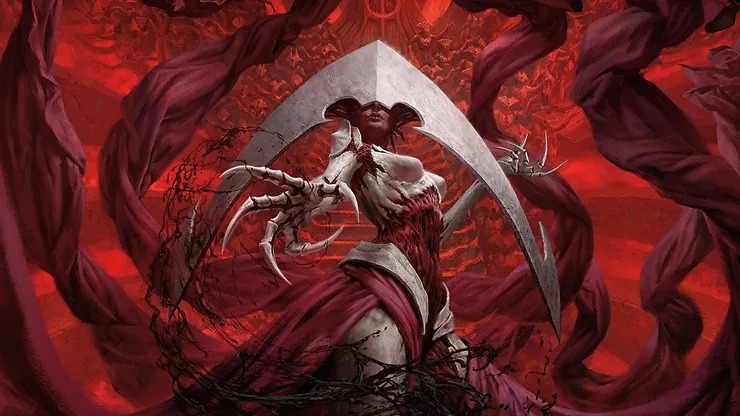What’s that strange oil? Probably nothing. Or it could mean we’re finally ready to start cracking packs of Phyrexia: All Will Be One!
Whether you’re heading to a pre-release event this weekend or are looking forward to drafting the set on Arena for the next few months, we’ve got you covered. This Phyrexia: All Will Be One Limited guide will give you everything you need to get familiar with the format.
We’ll cover the set’s many Limited mechanics, archetypes, and some of the best cards you should be keeping an eye out for. There’s a lot to cover, so let’s dive in!
Oh, and don’t touch anything. You never know where an enemy might be lurking.
Phyrexia: All Will Be One Limited Mechanics
Five key mechanics highlight Phyrexia: All Will Be One’s Limited environment. We’re getting an old favorite, a play on an old favorite, and a few new mechanics as well. This set looks like one of the more complicated in recent years from a Limited perspective with a lot of moving pieces and counters to keep track of.
Proliferate
Let’s get this one out of the way. Love it or hate it, proliferate is a major player in All Will Be One. You’ll find this returning mechanic stapled to instants, sorceries, and creatures of all shapes and sizes.
For those who aren’t familiar, proliferate allows you to choose permanents and/or players with counters on them. Then you add another of each existing counter type they already have. With the set’s other themes, proliferate promises to be an important mechanic.
Toxic
Speaking of, Phyrexia: All Will Be One brings back poison counters. These are assigned to a player and once they get 10, they lose the game. With the right strategy, this can be an efficient and difficult-to-deal-with alternative win condition.
Toxic is a reimagined version of the old infect mechanic. Instead of preventing damage and assigning poison counters based on a creature’s size, toxic adds poison counters based on the creature’s toxic number. Importantly, your creature still deals combat damage alongside the poison counters.
So, if a creature with “toxic 2” hits your opponent, they’ll lose two life, but also gain two poison counters.
Many people are referring to toxic as a “fixed” form of infect. Given its prevalence in the set, it will be an important mechanic to watch in Limited. We’ll see if this alternate win-con is efficient enough to get the job done.
Corrupted
Even if you aren’t killing your opponent with poison counters, they still matter in Phyrexia: All Will Be One Limited. A new mechanic, corrupted, cares about your opponent having three or more poison counters.
Cards with the corrupted mechanic offer a bonus effect or improved ability when it’s turned on. So while you’re pinging your opponent toward 10 poison counters, the rest of your strategy gets stronger.
This feels like an important addition for Limited. You might not always be able to finish your opponent off with poison (remember, you’re still doing combat damage) and benefitting from your toxic creatures feels good. The ultimate success of corrupted in Limited will largely depend on how easy it is to add those first three poison counters.
For Mirrodin!
Very similar to living weapon, For Mirrodin! is found on select equipment cards in All Will Be One. When the equipment enters the battlefield (ETBs), you create a 2/2 red Rebel creature token and attach the equipment to it.
The equipment cards featuring the For Mirrodin! mechanic are pretty heavily overcosted. However, they do provide a free body, and having the equipment stick around as upside if the token dies is decent.
There are 10 For Mirrodin! cards in the set with eight of them at uncommon or common. This feels like a purposeful Limited inclusion, so we’ll have to wait and see how it plays out. I wouldn’t be surprised if it turns out to be fairly strong, but definitely don’t expect For Mirrodin! to break the format.
Oil Counters
Poison counters not enough for you? No worries! Phyrexia: All Will Be One Limited introduces us to oil counters. This new counter type is very diverse and powers-up a wide range of effects.
Some cards want a certain number of oil counters on them to unlock an extra ability to buff their stat line. Others allow you to add, remove, or move oil counters to do something.
While oil counters will work nicely in some archetypes, and are a bonus if you’re proliferating, they feel pretty unexciting.
Phyrexia: All Will Be One Limited Archetypes
With the set mechanics out of the way, it’s time to dive into what you should look for when drafting or building a Limited deck for Phyrexia: All Will Be One.
This is a traditional two-color set with 10 unique archetypes to build around. As usual, there is some overlap among the pairings, allowing you to splash a third color for certain effects or bombs.
Speaking of bombs, this set feels “princey” with lots of cards that can run away with the game. We also have 10 planeswalkers to consider, including five that aren’t mythic.
Nonetheless, sticking to these strategies is generally solid. Let’s look at the Limited archetypes for Phyexia: All Will Be One.

White/Blue (Azorius): Artifacts
Highlighting the Azorius color pairing this time around is the artifact theme. There are plenty of cheap, evasive artifacts to pick up in these colors and rewards for playing them.
Cephalopod Sentry can be a massive flying threat if you fill your board with them. Meanwhile, cheap threats like Macator’s Watcher offer a solid body as well as a powerful effect.
Remember that mite tokens are also artifacts, so any card generating mites is important for the archetype. There are plenty to be found in white.

Green/White (Selesnya): Toxic Aggro
Selesnya deviates from its heavy counter/lifegain identity here for a more aggressive tilt. It also utilizes green’s heavily toxic identity in the set to push through damage and poison counters.
Slaughter Singer is a solid toxic threat on its own. However, it also pumps your other toxic creatures during combat. This effect, and others like it, are strong for the green/white archetype in ONE.
Keep an eye out for other aggressive cards like Branchblight Stalker, Flensing Raptor, and Noxious Assult.

Blue/Black (Dimir): Proliferate Control
Can you believe WotC made Dimir the proliferate pairing in All Will Be One…? Oh, and it looks to control the game!
Classic Dimir shenanigans take the form of Voidwing Hybrid this time around. This two-mana flier is the perfect way to land a poison counter on your opponent. Then, it rewards you for proliferating by returning from the graveyard to your hand. Not bad since you’re also increasing your opponent’s number of poison counters.
Keep an eye out for other proliferating threats like Thrummingbird, Blightbelly Rat, and Scheming Aspirant. If you ever manage to pull a Vraska, Betrayal’s Sting, your opponent should be worried.

Black/Red (Rakdos): Oil Counters and Sacrifice
Yes, Rakdos still wants to sacrifice stuff. But this time, you also get to play around with oil counters. This color pairing has some of the best oil counter enablers in the set and plenty of ways to use them.
Charforger gives you sac foddering when it ETBs and can fill up with oil counters quickly when you sacrifice creatures. Then you’re rewarded with card advantage when you remove oil counters from it. This card summarizes exactly what you want to do with this archetype. Be aggressive. Sacrifice stuff. Add oil counters. Remove oil counters. Profit?
Look out for Forgehammer Centurion, Necrosquito, and Ichorplate Golem to power up your strategy.

Red/Green (Gruul): Midrange Oil Counters
If you’re high on oil counters but like to keep your stuff around, perhaps consider heading in the Gruul direction. Rather than focusing on sacrificing, red/green features creatures with activated abilities that need oil counters or abilities that look for them.
Cinderslash Ravager is a good example, rewarding you with a chunky threat for a great price if you can add oil counters to your board efficiently. It second ability can help clean up blockers that were already dealt combat damage or sweep away a board of troublesome mites.
While you’re mining for oil counters, look for cards like Predation Steward, Oil-Gorger Troll, and Urabrask’s Anointer.

Green/Blue (Simic): Poison Proliferate
If you like Golgari’s poison plan and Dimir’s proliferate plan, Simic is your sweet spot. This archetype uses cards that focus on toxic and proliferate to build interactive decks with a fast clock.
Tainted observer (that art though!) lets you do both things with ease. It adds poison counters with toxic and evasion. Then, you can pay two generic mana to proliferate whenever a creature you control ETBs. It’s not hard to see this being a key piece of an early aggressive strategy that also enables a combo finish at the end.
Like the other archetypes that use poison and proliferate, Thrummingbird will shine here. Keep an eye out for Mesmerizing Dose as solid “removal” and Experimental Augury as well.

Red/White (Boros): For Mirrodin! (Equipment) Aggro
The only archetype to not feature a gold-bordered creature at uncommon, Boros is all about equipment. Its signpost uncommon screams that since it is an equipment featuring the For Mirrodin! mechanic.
Bladehold War-Whip is arguably the best of the For Mirrodin! equipments. For just three mana, you get a 2/2 double striker. And the artifact itself reduces your equip costs for other equipments. If you can snag a few pieces of equipment alongside a War-Whipe, you’ll be in good shape.
There is some strong support here in the form of Bladegraft Aspirant, Leonin Lightbringer, and Oxidda Finisher (appropriately named). Equipment archetypes tend to be fragile, but For Mirrodin! takes some of the sting away. You can also play more equipment without worrying about your creature count since the mechanic gives you a creature.
We’ll have to see how this archetype plays out, but it’s one I’m very excited to build around.

Black/Green (Golgari): Poison
Going all-in on poison counters is Golgari’s theme in All Will Be One. There is plenty of support for it, too.
Necrogen Rotpriest is a powerhouse at uncommon, letting all your toxic creatures add an additional poison counter when they deal combat damage. Combine early aggressive creatures with solid high-end finishers like Paladin of Predation and you’ve got a winning strategy. Not to mention some excellent removal like Vraska’s Fall, Sheoldred’s Edict, and Cankerbloom.
On paper, this archetype looks incredibly strong with plenty of support. However, we’ll have to see if other archetypes start to leech too many toxic threats or removal out of Golgari’s grasp.

Blue/Red (Izzet): Non-creature Spells and Oil Counters
Heard this one before? Izzet wants to cast non-creature spells. This time, the reward is oil counters. There are several enablers that add oil counters when you cast non-creature spells and rewarding ways to use them.
Serum-Core Chimera is the signpost uncommon, following this strategy and giving you a direct damage outlet when you discard a nonland card and remove three oil counters from it.
You’ll need quite a bit of synergy here to maximize your non-creature spells. The payoffs aren’t the greatest in Izzet, but you may be able to find wide-open draft lanes in this archetype if other players are avoiding it.

Black/White (Orzhov): Corrupted
Our final archetype again makes use of poison counters. However, Orzhov puts less emphasis on winning with poison and more on getting just enough to turn on corrupted. Once you give your opponent three poison counters, you turn on the mechanic, powering up your creatures and making your spells more effective.
Vivisection Evangelist offers a solid body with a potent ETB if corrupted is on. Apostle of Invasion and Ravenous Necrotitan are also huge threats for this archetype.
This looks like another very strong color pairing. It’s also very splashable with green for more poison effects.
ONE Limited Tips and Tricks
There are going to be a lot of things to consider when queuing up in a Limited match for Phyrexia: All Will Be One. While many will be in-game decisions to make, here are a few tips and tricks to keep stored away in the back of your mind.
- Proliferate enhances both toxic and oil counters.
- Corrupted is flexible, both as a passive way to add value or a dedicated strategy.
- Splashing is fairly easy in this set (easier than BRO, but not as easy as DMU).
- Aggressive archetypes are poised for success here while players durdle with poison counters and oil counters. Don’t be afraid to go face.
- Double-strike gives you two toxic triggers
- Dabbling in poison/toxic to threaten your opponent and threaten corrupted is a smart play. You don’t have to commit to it fully since you still deal combat damage.
- Mites make excellent sacrifice fodder but can also threaten a go-wide plan.
Conclusion
There’s a lot to like about Phyrexia: All Will Be One! The Limited environment looks super promising after a “meh” Brother’s War overshadowed by the artifact archive.
With a much more traditional set on our hands this time, it will be fun to see how players pick up these archetypes and find success.
What do you think about All Will Be One? Let us know in the comments or on social media.


 Support us on
Support us on 
